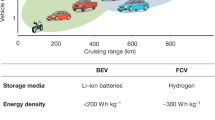Abstract
The past decade has seen tremendous advances in proton exchange membrane fuel cell (PEMFC) technology: However, there remain many challenges to bring commercially viable stationary PEMFC products to the market. This review, from a manufacturer's perspective, focuses on system reliability and materials compatibility and their strong impact on stack life and overall system durability. Statistical analysis is based on field data from more than 600 stationary PEMFC systems for both continuous and back-up power applications. Sealing materials and coolants are used to illustrate the approaches taken to evaluate materials compatibility studies.
Similar content being viewed by others
References
W. Vielstich, A. Lamm, and H.A. Gasteiger, eds., Handbook of Fuel Cells-Fundamentals, Technology, and Applications (New York: John Wiley & Sons, 2003).
F. de Bruijn, Green Chem., 7 (2005), pp. 132–150.
M. Winter and R.J. Brodd, Chem. Rev., 104 (2004), pp. 4245–4269.
V.S. Bagotzky, N.V. Osetrova, and A.M. Skundin, Russ. J. Electrochem., 39 (9) (2003), pp. 919–934.
P. Costamagna and S. Srinivasan, J. Power Sources, 102 (2001), pp. 242–252.
P. Costamagna and S. Srinivasan, J. Power Sources, 102 (2001), p. 253–269.
V. Mehta and J.S. Cooper, J. Power Sources, 114 (2003), pp. 32–53.
H.A. Gasteiger and M.F. Mathias, Proc. Electrochem. Soc., Proton Conducting Membrane Fuel Cells III, PV2002-31, eds. M. Murthy et al. (Pennington, N.J.: The Electrochemical Society, 2005), pp. 1–24.
S.M. Haile, Acta Mater., 51 (2003), pp. 5981–6000.
N.P. Brandon, S. Skinner, and B.C.H. Steele, Annu. Rev. Mater. Res. 33 (2003), pp. 183–213.
H.A. Gasteiger et al., Appl. Catal. B, 56 (2005), pp. 9–35.
B. Wang, J. Power Sources, 152 (2005), pp. 1–15.
E. Antolini, J. Appl. Electrochem., 34 (2004), pp. 563–576.
E. Antolini, J. Mater. Sci., 38 (2003), pp. 2995–3005.
E. Antolini, Mater. Chem. Phys., 78 (2003), pp. 563–573.
S. Litster and G. McLean, J. Power Sources, 130 (2003), pp. 61–76.
T.R. Ralph and M.P. Hogarth, Platinum Metal Rev., 46 (3) (2002), pp. 117–135.
N.M. Markovic and P.N. Ross, CATTECH, 4 (2) (2000), pp. 110–126.
R. Souzy and B. Ameduri, Prog. Polym. Sci., 30 (2005), pp. 644–687.
M.A. Hickner and B.S. Pivovar, Fuel Cells, 5 (2) (2005), pp. 213–229.
K.A. Kenneth and R.B. Moore, Chem. Rev., 104 (2004), pp. 4535–4585.
M.A. Hickner et al., Chem. Rev., 104 (10) (2004), pp. 4587–4611.
D.E. Curtis et al., J. Power Sources, 131 (2004), pp. 41–48.
X. Li and I. Sabir, Int. J. Hydrogen Energy, 30 (4) (2001), pp. 359–371.
A. Hermann, T. Chaudhuri, and P. Spagnol, Int. J. Hydrogen Energy, 30 (12) (2005), pp. 1297–1302.
R.J. Farrauto, Appl. Catal. B, 56 (1–2) (2005), pp. 3–7.
J. van Herle, Chimia, 58 (12) (2004), pp. 887–895.
R.J. Farrauto et al., Annu. Rev. Mater. Res., 33 (2003), pp. 1–27.
C.-S. Song, Catal. Today, 77 (2002), pp. 17–49.
E. David, J. Mater. Proc. Tech., 162–163 (2005), pp. 169–177.
F. Schüth, B. Bogdanović, and M. Felderhoff. Chem. Commun. (2004), pp. 2249–2258.
G. Sandi, Electrochem. Soc. Interface, 13 (3) (2004), pp. 40–44.
U.S. Department of Energy, “Multi-Year Research, Development and Demonstration Programs for Hydrogen, Fuel Cells & Infrastructure Technologies Program’ (last revised on January 21, 2005). www. eere.energy.gov/hydrogenandfuelcells/mypp/.
S.D. Knight et al., J. Power Sources, 127 (2004), pp. 127–134.
S. Ibe et al., 2003 Fuel Cell Seminar Abstracts (St. Louis, MO: Mira Digital Publishing, 2003), pp. 941–944.
A.S. Feitelberg et al., J. Power Sources, 147 (2005), pp. 203–207.
M.K. White et al., 2004 Fuel Cell Seminar Abstracts (St. Louis, MO: Mirra Digital Publishing, 2004), pp. 160–163.
See for example: B.C. Davenport, Plug Power Fuel Cell Demonstration Project at the Watervliet Arsenal, (DACA42-01-C-0053), Interim Final Project Report to DOD (Latham, NY: 21 March 2003).
Detailed performance data atvarious Department of Defense sites are available at: http://dodfuelcell.cecer. army.mil/res/site_performance.php4.
T.W. Patterson and R.M. Darling, Electrochem. Solid-State Lett, 9, (2006), pp. A183-A185.
A. Taniguchi et al., J. Power Sources, 130 (2004), pp. 42–49.
C.A. Reiser et al., Electrochem. Solid-State Lett., 8 (2004), pp. A273-A276.
M. Schulze et al., J. Power Sources, 127 (2005), pp. 222–229.
K. Narusawa et al., JSAE Review, 24 (1) (2003), pp. 41–46.
R.C. Makkus et al., J. Power Sources, 86 (2000), pp. 274–282.
J. St-Pierre, J. New Mater. Electrochem. Systems, 3 (2000), pp. 99–106.
V. Stanic and M. Hoberecht, 2004 Fuel Cell Seminar Abstracts (St. Louis, MO: Mira Digital Publishing, 2004), pp. 85–88.
Plug Power internal data (2006).
A. Peterson, K.-S. Im, and M.-C. Lai, Proc. 3rd Intl. Conf. Fuel Cell Sci. Eng. Tech., ed. R.K. Shah, E. Ubong, and S. Samuelsen (New York: ASME, 2005), pp. 713–719.
L.-D. Chen, J.A. Schaeffer, and J.P. Seaba, “A Simulink Model for Calculation of Fuel Cell Stack Performance,” FUEL-143. Technical Program for the 228th ACS National Meeting, Philadelphia, PA 22–26 Ausgust 2004.
M. Katz, J. Electrochem. Soc., 125 (4) (1978), pp. 515–520.
P. Rapaport and J.P. Healy, U.S. patent 6,773,841 (2004).
R.P. Roche and M.P. Nowak, U.S. patent 5,079,104 (1992).
R.C. Nickols and J.C. Trocciola, U.S. patent 3,940,285 (1976).
M. Katz, S.W. Smith, and D. Reitsma, U.S. patent 3,923,546 (1975).
Rights and permissions
About this article
Cite this article
Du, B., Guo, Q., Pollard, R. et al. PEM fuel cells: status and challenges for commercial stationary power applications. JOM 58, 45–49 (2006). https://doi.org/10.1007/s11837-006-0053-5
Issue Date:
DOI: https://doi.org/10.1007/s11837-006-0053-5




